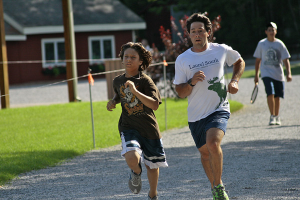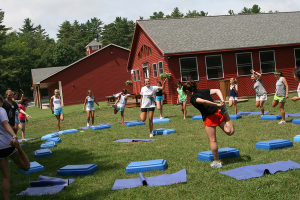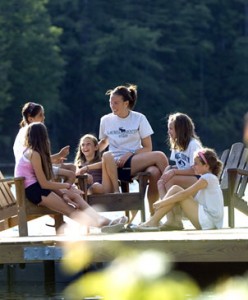 So you’ve gotten a great job at a summer camp and are wondering what to do while you impatiently wait for June to get here…
So you’ve gotten a great job at a summer camp and are wondering what to do while you impatiently wait for June to get here…
First things first. You found this blog, so we’re assuming you want to know as much as you can before you leave. You’ve come to the right place! We’ve got a few suggestions for you…Actually, a lot. In fact, since we understand that you’ve come to this site to read a blog, not War and Peace, we’re going to have to divide this into a few different parts. But we figure that’s okay because they do it with movies all of the time, right? So without any further delay…
Have you started checking out your camp’s blog as well as this one? Many camps now maintain regular blogs and they frequently post blogs (like this one) intended specifically for staff members.
now maintain regular blogs and they frequently post blogs (like this one) intended specifically for staff members.
Check out the camp’s website, if you haven’t about a thousand times already. Even if you visit the website everyday and spend hours staring dreamily at the photos as you imagine images of you having the perfect summer showing up on the site this time next year, dig a little deeper. A camp’s website can also tell you a lot about the very special world that you will be part of this summer. Many camps have FAQ pages for staff members or special staff areas. They give you ideas about what to bring and what to leave at home. Some post sample daily schedules, which are a great way to familiarize yourself with how you will be spending your days. If there are videos on the site (or if the camp sent you one), watch them. Not only will you be ready to leave the same day, but it’s a great way to get to know the camp.
 If the camp has Facebook or Twitter pages, join them. They’re another way to keep up to date on what’s happening and, as summer inches closer, the anticipation that builds is infectious. Many camps also post helpful information or instructions for staff members as summer nears. Facebook and Twitter are great ways to connect with other staff members before you get to camp. Not to worry, though. You’ll make PLENTY of new friends during your Orientation, even if you show up knowing no one!
If the camp has Facebook or Twitter pages, join them. They’re another way to keep up to date on what’s happening and, as summer inches closer, the anticipation that builds is infectious. Many camps also post helpful information or instructions for staff members as summer nears. Facebook and Twitter are great ways to connect with other staff members before you get to camp. Not to worry, though. You’ll make PLENTY of new friends during your Orientation, even if you show up knowing no one!
 Prepare to work hard. We won’t lie. Camp is one of the hardest jobs you’ll ever have. It’s also one that you’ll probably love the most. Every second of every day, SOMETHING is happening at camp. It’s all a lot to take in at first, but the chances of you making it through the last day at camp without shedding a single tear and hugging hundreds of people are pretty much nil-to-none. And you’ll probably be making plans to come back next summer before this one’s even over.
Prepare to work hard. We won’t lie. Camp is one of the hardest jobs you’ll ever have. It’s also one that you’ll probably love the most. Every second of every day, SOMETHING is happening at camp. It’s all a lot to take in at first, but the chances of you making it through the last day at camp without shedding a single tear and hugging hundreds of people are pretty much nil-to-none. And you’ll probably be making plans to come back next summer before this one’s even over.
Well, like we said, we’re well aware that if you were looking for a novel, you’d be downloading the latest best seller for you Kindle right now. So we’ll call it a day for this blog. Be sure to tune in next time for advice about what to pack (and not) and some tips for orientation.
























 Whether your Holiday Season has ended or is about to begin, summer camp season isn’t far away! In fact, on December 8th 2010, next year’s campers wore their camp shirts in numerous cities to mark the 200 Day Countdown To Summer. If you’ve never gone to camp, it may be difficult to understand what drives this passion for camp all year—but campers know that camp is contagious, FUN, and essential! The camp experience helps children develop into well-rounded adults in enormous and complex ways, and that’s really important—but having FUN and intense youthful experiences is how it all happens. That’s the brilliant combination of camp. The experience includes serious AND hilarious moments—often simultaneously! The whole experience is much like the two sides of a single coin, or the double-faced image of Janus, the Roman god who can see into the past and future at the same time—and the origin of the name for the first month—January.
Whether your Holiday Season has ended or is about to begin, summer camp season isn’t far away! In fact, on December 8th 2010, next year’s campers wore their camp shirts in numerous cities to mark the 200 Day Countdown To Summer. If you’ve never gone to camp, it may be difficult to understand what drives this passion for camp all year—but campers know that camp is contagious, FUN, and essential! The camp experience helps children develop into well-rounded adults in enormous and complex ways, and that’s really important—but having FUN and intense youthful experiences is how it all happens. That’s the brilliant combination of camp. The experience includes serious AND hilarious moments—often simultaneously! The whole experience is much like the two sides of a single coin, or the double-faced image of Janus, the Roman god who can see into the past and future at the same time—and the origin of the name for the first month—January. The serious side of camp includes feeling part of a unique community, identity development and participating through the years to make irreplaceable memories. If you don’t understand why camp is such an important American institution, in 1998 Ira Glass and the This American Life radio program attempted to investigate the topic
The serious side of camp includes feeling part of a unique community, identity development and participating through the years to make irreplaceable memories. If you don’t understand why camp is such an important American institution, in 1998 Ira Glass and the This American Life radio program attempted to investigate the topic It also highlights how fun, tradition, stories, community and being human are all part of identity development at camp. With his signature quirky style, Ira assembled more “truth is stranger than fiction tales,” where real campers tell stories of camp in days gone by and explain why the camp experience is so special. Hundreds of campers responded to his call for stories and the program shares a selection, so if you’re interested in history and interpreting American culture, you’ll find the reminiscences fascinating. Just remember that all camp experiences are not like the stories told—the point of the program is to illustrate the intensity of the experience! It ends with campers talking about becoming camp alumni and how their camp experiences won’t ever be forgotten.
It also highlights how fun, tradition, stories, community and being human are all part of identity development at camp. With his signature quirky style, Ira assembled more “truth is stranger than fiction tales,” where real campers tell stories of camp in days gone by and explain why the camp experience is so special. Hundreds of campers responded to his call for stories and the program shares a selection, so if you’re interested in history and interpreting American culture, you’ll find the reminiscences fascinating. Just remember that all camp experiences are not like the stories told—the point of the program is to illustrate the intensity of the experience! It ends with campers talking about becoming camp alumni and how their camp experiences won’t ever be forgotten. As we all know, time passes and our camp years are limited by the fact that we’re only children once. It’s easy to feel briefly melancholy at year’s end as time waits for no one, but of course, December also means that the promise of a new year is around the corner! In January, we’d like to continue looking backwards and forwards while thinking about camp and we’d especially love to hear from camp alumni. What’s the funniest thing that happened to you at camp? How did camp contribute to your adult life? We’d like to hear about the memories you hold dear and close to your heart, or what you wish for campers next year? If you’re counting the days until camp starts, what are YOU planning?
As we all know, time passes and our camp years are limited by the fact that we’re only children once. It’s easy to feel briefly melancholy at year’s end as time waits for no one, but of course, December also means that the promise of a new year is around the corner! In January, we’d like to continue looking backwards and forwards while thinking about camp and we’d especially love to hear from camp alumni. What’s the funniest thing that happened to you at camp? How did camp contribute to your adult life? We’d like to hear about the memories you hold dear and close to your heart, or what you wish for campers next year? If you’re counting the days until camp starts, what are YOU planning?
 How would you describe the essential elements of a summer camp? Do the adventures of spending days with peers, learning new skills, trying new activities, bonfires and skits, great counselors— all the fun of the whole experience— first come to mind? These are definitely important elements of summer camp from a camper’s perspective, but there are a lot of other elements that have to be in place for a camp to be successful year after year. Have you ever wondered what it takes to set the scene and develop communities where good times can take place? I have.
How would you describe the essential elements of a summer camp? Do the adventures of spending days with peers, learning new skills, trying new activities, bonfires and skits, great counselors— all the fun of the whole experience— first come to mind? These are definitely important elements of summer camp from a camper’s perspective, but there are a lot of other elements that have to be in place for a camp to be successful year after year. Have you ever wondered what it takes to set the scene and develop communities where good times can take place? I have.
